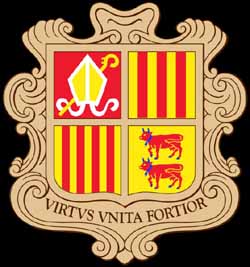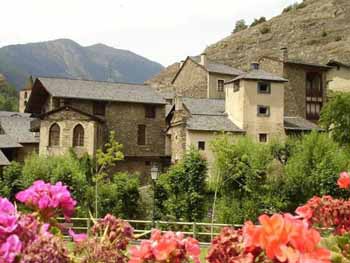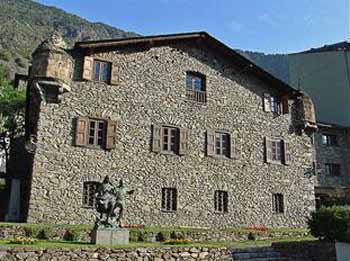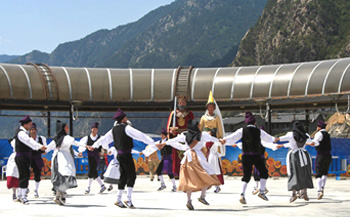 |
Organic Society
Andorra, the Forgotten Principality
Hugh O’Reilly
Do you know of any principality that has lived peacefully for seven centuries, far from the conflicts that have spilled blood throughout the world? A country that conserved its multi-century traditions and still lives in the contemporary world?
It is right there, with its 180 square miles in the heart of Europe, between France and Spain, nestled in the bosom of the Pyrenees Mountains. It is Andorra – les Valles d’Andorra – as they say in Catalan, the official language of the country.

The coat-of-arms of Andorra |
Born in the Middle Ages, its institutions have survived until our days almost unchanged. Some authors, confused by the originality of its government, have called it the Andorran Republic. However, even if the way the State works is quite democratic, Andorra is in fact a parliamentary principality, or to be more precise, a “co-principality.” As a matter of fact, two “co-princes” of equal dignity have exercised their sovereignty there for many centuries. One is the Bishop of Urgell and the other, the President of France.
How was this Principality established? Its unusual situation deserves an explanation. A golden legend tells us that Charlemagne himself granted liberty to the Andorrans to reward them for their help in combating the Moors in Spain. Their national anthem proudly proclaims this imperial paternity: El gran Carlemany men Pars, dels Alarbs me desllivrà… The great Charlemagne, my Father, freed me from the Arabs.
From the 9th century on, the Bishops of Urgell gradually extended their authority to cover the seven parishes that today form the Principate. In January 1176, the Andorrans signed a concordat with the reigning Bishop of Urgell, Bernard Sanç, recognizing him as their sovereign.
Since the Church of Urgell was unable to provide the needed military protection to its subjects, Andorra was given as a feudal property to the Counts of Caboet. By marriage this right passed to the House of Castalbé. In 1208, Roger Bernard de Foix married the last heir of the House of Castalbé. A dark period of brutal fighting followed between the Bishop of Urgell and his powerful vassals, on one hand, and the Count of Foix on the other.

Residences in the Valley, above, and overlooking it, below

|
On September 8, 1278, aware of his military weakness, Bishop Pere d’Urtx agreed to a first paréage, or peerage, with his adversary. In this case, a feudal treaty recognized the joint sovereignty over the territory by the two rulers, who were on an equal footing.
This circumstantial agreement between the Bishops of Urgell and the Counts of Foix would have an astonishing longevity. That first peerage, along with a second in 1288, provided the foundation for the independence and unique government of the Andorran Valley.
While the Bishops of Urgell conserve to this date their prerogative, the Counts of Foix passed theirs to the Sovereigns of Navarre as a consequence of marriage alliances. When Henry III of Navarre became Henry IV of France in 1589, he added the Andorran co-sovereignty to the French Crown. This is why the Presidentsof France today uses the title of co-Prince of Andorra, as the supposed continuer of the French Monarchy and remote successor to the Counts of Foix.
Over the centuries under the protection of its two sovereigns – “the two courageous tutors” – a nation was born and developed its distinctive characteristics. However, the actually framework of the public administration is defined by two 13th century letters.
The co-Princes are represented in Andorra by both a Church representative and a French delegate, who exercise the judicial functions. Two permanent delegates, one from the Urgell Diocese and another from Perpignan, have certain legislative powers and can judge court appeals. Several other parishes are governed following established customs and privileges.

Traditional dances & customs of the Andorran Valley |
The supreme authority of the country is the General Council, which consists of 28 Councilors who are elected by the seven parishes and serve four-year terms. This Parliament makes the laws and establishes the taxes. Each year the principal representative of the Council, in a ceremony of pomp and circumstance, pays the feudal tribute to the lords, that is, 460 pesetas to the Bishop of Urgell and 960 francs to the French President, along with interest in goods: 12 blocks of cheeses, 12 capons, 12 quails and 6 hams!
Faithful to their co-Princes, the Andorrans are also faithful to the Catholic Faith of their ancestors. Their national feast is Our Lady of Meritzell day on September 8, where the people come together for a grand celebration to crown the Virgin of Meritxell, Patroness of the country. The authorities of Andorra make an official pilgrimage to the Marian sanctuary each year for the festivity.
Thus lives Andorra, “the only living daughter of the Emperor Charlemagne, free and Catholic.”

Translated and based upon Philippe Delorme, Andorre, La Principaté Oublié
Point de Vue, September 29, 1989, pp. 40-41
Posted August 15, 2009

Related Topics of Interest
 The Peasant-Nobles of the Roncal Valley - Part I The Peasant-Nobles of the Roncal Valley - Part I
 The Peasant-Nobles of the Roncal Valley - Part II The Peasant-Nobles of the Roncal Valley - Part II
 The Organic Formation of Groups of Friends The Organic Formation of Groups of Friends
 Vocations of the European Peoples Vocations of the European Peoples
 The Role of Admiration and Affection in the Family The Role of Admiration and Affection in the Family
 What Is Organic Society? What Is Organic Society?

|
Organic Society | Social-Political | Home | Books | CDs | Search | Contact Us | Donate

© 2002-
Tradition in Action, Inc. All Rights Reserved
|
 |
|